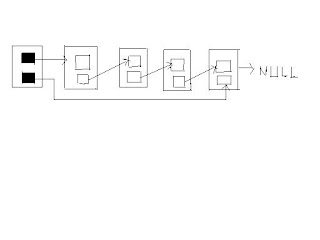/* Programmer: Julie Ann Pabio
Program name: A Stack Code Implementation
Purpose: To implement a Stack Code.
Instructor: Dony Dongiapon
Subject: IT123 Data Structures*/
//a class which declares the variables and the constructors
class Link{
public int iData=0;
public Link(int iData, )
iData=id;
}
public void displayLink()
{
System.out.println(iData+":" );
}
}
//the class which contains the methods or the operations on the stack
class StackList{
private Link first;
public StackList(){
first=null;
}
public boolean isEmpty() {
return (first == null);
}
public void insertFirst( int id) {
Link newLink = new Link( id);
newLink.next = first;
first = newLink;
}
public Link deleteFirst()
{
Link temp=first;
return temp;
}
public Link pick()
{
Link temp=first;
return temp;
}
public void displayList //display the data
{
System.out.print("Elements on the stack: ");
Link temp=first;
while(temp!=null)
{
temp.displayList();
}
System.out.println(" ");
}
}
//the main class which applies the methods on the stack
class StackListApp
{
public static void main (String[]args)
{
StackList theList=new StackList();
theList.insertFirst(12);
theList.insertFirst(25);
theList.insertFirst(91);
//when deleting
//just erase the comment if you want to run the method of deletion
theList.deleteFirst();
//when displaying the element
theList.displayList();
}
}
Sunday, February 15, 2009
Thursday, February 12, 2009
References:
http://www.java2s.com/Tutorial/Java/0140__Collections/Adoublylinkedlist.htm
http://www.java2s.com/Tutorial/Java/0140__Collections/DoubleEndedListslistwithfirstandlastreferences.htm
http://www.java2s.com/Tutorial/Java/0140__Collections/Demonstratingastackimplementedasalist.htm
http://www.java2s.com/Tutorial/Java/0140__Collections/AQueueImplementedbyaLinkedList.htm
http://www.java2s.com/Tutorial/Java/0140__Collections/Adoublylinkedlist.htm
http://www.java2s.com/Tutorial/Java/0140__Collections/DoubleEndedListslistwithfirstandlastreferences.htm
http://www.java2s.com/Tutorial/Java/0140__Collections/Demonstratingastackimplementedasalist.htm
http://www.java2s.com/Tutorial/Java/0140__Collections/AQueueImplementedbyaLinkedList.htm
Tuesday, February 10, 2009
Implementation of Double-Ended List
class Link {
public int iData;
public double dData:
public Link next;
public Link(int id,double dd) {
iData = id;
dData=dd;
}
public void displayLink(){
System.out.print("{"+iData+","dData+"}");
}
}
class FirstLastList {
private Link first;
private Link last;
public FirstLastList() {
first = null;
last = null;
}
public boolean isEmpty() {
return (first == null);
}
public void insertFirst(int id,double dd) {
Link newLink = new Link(id,dd);
if (isEmpty ())
last = newLink;
newLink.next = first;
first = newLink;
}
public void insertLast(int id,double dd) {
Link newLink = new Link(id,dd);
if (isEmpty())
first = newLink;
else
last.next = newLink;
last = newLink;
}
public Link deleteFirst(int id,double dd) {
int temp = first.iData;
if (first.next == null)
last = null;
first = first.next;
return temp;
}
public Link deleteLast(int id, double dd){
int temp=last.iData;
if(last.next==null)
first=null;
last=last.next;
return temp;
}
public void displayList(){
System.out.print("List(first-->Last);");
Link current=first;
while(current!=null){
current.displayLink();
current=current.next;
}
}
System.out.println(" ");
}
}
public class FirstLastApp{
public static void main(String[] args) {
FirstLastList theList = new FirstLastList();
theList.insertFirst(22,2.99);
theList.insertFirst(44,4.99);
theList.insertFirst(66,6.99);
theList.insertLast(11,1.99);
theList.insertLast(33,3.99);
theList.insertLast(55,5.99);
System.out.println(theList);
theList.deleteFirst();
theList.deleteFirst();
System.out.println(theList);
}
}
class Link {
public int iData;
public double dData:
public Link next;
public Link(int id,double dd) {
iData = id;
dData=dd;
}
public void displayLink(){
System.out.print("{"+iData+","dData+"}");
}
}
class FirstLastList {
private Link first;
private Link last;
public FirstLastList() {
first = null;
last = null;
}
public boolean isEmpty() {
return (first == null);
}
public void insertFirst(int id,double dd) {
Link newLink = new Link(id,dd);
if (isEmpty ())
last = newLink;
newLink.next = first;
first = newLink;
}
public void insertLast(int id,double dd) {
Link newLink = new Link(id,dd);
if (isEmpty())
first = newLink;
else
last.next = newLink;
last = newLink;
}
public Link deleteFirst(int id,double dd) {
int temp = first.iData;
if (first.next == null)
last = null;
first = first.next;
return temp;
}
public Link deleteLast(int id, double dd){
int temp=last.iData;
if(last.next==null)
first=null;
last=last.next;
return temp;
}
public void displayList(){
System.out.print("List(first-->Last);");
Link current=first;
while(current!=null){
current.displayLink();
current=current.next;
}
}
System.out.println(" ");
}
}
public class FirstLastApp{
public static void main(String[] args) {
FirstLastList theList = new FirstLastList();
theList.insertFirst(22,2.99);
theList.insertFirst(44,4.99);
theList.insertFirst(66,6.99);
theList.insertLast(11,1.99);
theList.insertLast(33,3.99);
theList.insertLast(55,5.99);
System.out.println(theList);
theList.deleteFirst();
theList.deleteFirst();
System.out.println(theList);
}
}
Friday, February 6, 2009
Illustration of Stack

Reference:http://en.wikipedia.org/wiki/Stack_(data_structure)
- This is a simple representation of a stack
The
Method Involve In Stack
Stack class represents a last-in-first-out (LIFO) stack of objects. The usual push and pop operations are provided, as well as a method to peek at the top item on the stack, a method to test for whether the stack is empty, and a method to search the stack for an item and discover how far it is from the top.Method Involve In Stack
push()
pop()
peek() or top()
isEmpty()
search()
size()
[java]
Reference:
http://java.sun.com/j2se/1.4.2/docs/relnotes/devdocs-vs-specs.html
Subscribe to:
Comments (Atom)


